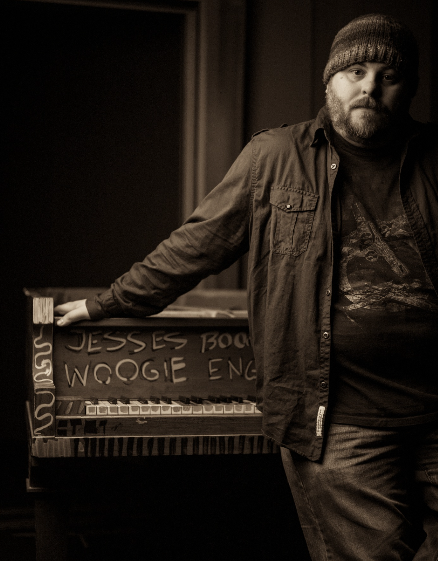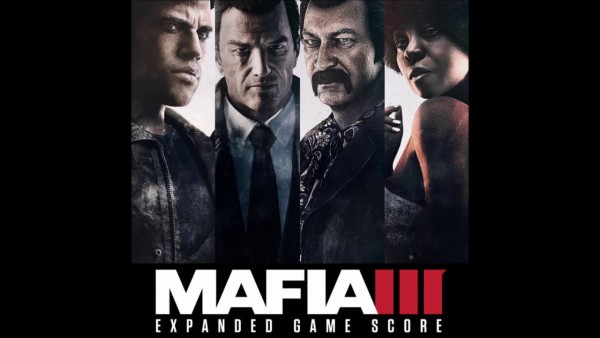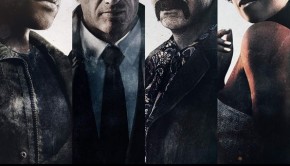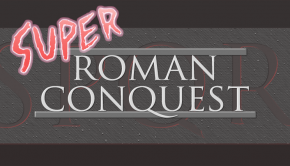Jesse Harlin Interview: Cinematic Scores of Mafia III
The Mafia series has had a rich musical tradition since Vladmir Simunek’s score to the first game. Mafia III, the most recent installment in the franchise, has taken a different approach to the music; composers Jim Bonney and Jesse Harlin fused Hollywood-orchestral sounds with strong blues elements for a new spin on the Mafia music.
In the first of a two-part Mafia interview, we spoke with Jesse Harlin about his game music origins and past composition work, as well as his foray into 2K Games’ Mafia series. Mafia III incorporates a lot of experimental instrumental techniques that Harlin discusses in depth, along with his work with co-composer Jim Bonney.
Interview Credits
Interview Subject: Jesse Harlin
Interviewer: Emily McMillan
Editor: Emily McMillan
Coordination: Jordan von Netzer, Chris Greening
Interview Content
Emily: Thank you for speaking with us! First, how did you get into cinematic and game music?
Jesse Harlin: Well, I’ve always loved cinematic music. One of my favorite albums when I was a kid was John Williams’ soundtrack for The Empire Strikes Back. As a 5 year old kid in the early 80s, I would lay on the sofa and just absorb the music coming out of the hi-fi speakers until it became part of my DNA. So, when I grew up and became a musician myself, I came to really love soundtracks and scores. So much so, in fact, that I decided I wanted to write them myself and started to study orchestration. While in school for film scoring, I had a realization that – while I loved writing cinematic music – my real love wasn’t film, but games. From that realization on, I focused all of my schooling and career on how to apply the concepts of cinematic film scoring to games.

Emily: Can you tell us about your involvement working on the Monkey Island 2 Special Edition? How did you become involved on that project?
Jesse Harlin: I was the on-staff Composer and Music Supervisor at LucasArts from 2003 until Disney shut the company down in 2013. As such, I had helmed the music for the first Secret of Monkey Island: Special Edition game. The original SoMI:SE game had been something I’d tackled entirely by myself, arranging and rerecording all of the tracks for the game. When Monkey Island 2L LeChuck’s Revenge – Special Edition came around, the Audio Department at LucasArts was absolutely slammed. I think we were working on six different games at the same time in one form or another, two of which were Star Wars: The Force Unleashed II and Star Wars: The Old Republic. Needless to say, we were spread too thin. So, when the team approached me about MI2:LESE, I knew there was no way I was going to be able to do the whole thing like I did with SoMI:SE. I functioned on the sequel much more as a Music Supervisor, managing a crew of arrangers that I hired and working with them to guide them through the process.
Emily: What work did you do, or what influences did you have, on the newly arranged score as music supervisor?
Jesse Harlin: Unlike SoMI:SE, there’s only one section of the score that I was able to redo myself, and that was the music for Captain Dread and his ship, the Jolly Rasta. I could tell that the original version of the music was reggae-inspired, but for me it didn’t swing enough. So, I cranked up the swung reggae factor by about 1000%. Otherwise, I was mostly just giving direction on that project. The goal was the same as the first one: take what was originally MIDI instruments and try and turn them into new recordings using as many live instruments as possible, or failing that, modern sample versions. I was giving the arrangers lots of disparate influences to listen to: mechanical self-playing orchestrions, funeral dirges, reggae, tropical ukulele music. The original music from the game is wonderfully eclectic, so I got to have a good time as a shaper and a sculptor, essentially.

Emily: Moving onto the Mafia series, how did you come to be on board with Mafia III?
Jesse Harlin: Many of the folks working on Mafia III were people that I’d worked with at LucasArts, specifically on The Force Unleashed and its sequel. Their Audio Director, Matt Bauer, and I had scored an animated short film together in 2012 and I really enjoyed working with him. When Matt contacted me and asked if I’d be interested in working with them on a new game, it didn’t matter what the game was going to be, I was in. The fact that it was Mafia III was even better.
Emily: You’ve mentioned that you were determined to keep this score “cinematic.” Did you have any concern about being too influenced by the previous composers on the series, or picking up your own musical chapter of the series?
Jesse Harlin: No, I knew that 2K was going to be going for something very different with this game than they had for Mafia and Mafia II. We spent a lot of time at the outset of the project talking about different styles and directions to take the score in: rock, funk, blues, orchestral. I listened to the scores for Mafia and Mafia II just to see if they had themes that needed to return or be reimagined, but we were pretty set from the beginning on heading into a different direction and not doing an orchestral score. There’s one main character that returns in Mafia III from Mafia II, a mobster named Vito, and I did use the main theme from Mafia III as “Vito’s theme” in the game, though run through a blues filter instead of an orchestral one.
Emily: The sound of Mafia III is very different from the first two games, which both have very standard, Hollywood-orchestral scores; Mafia III has this raw blues sound. Why did you decide to take it in direction, and how did that mesh with the cinematic approach of the score?
Jesse Harlin: When we started, 2K was clear they were going to be taking some risks with the story and I wanted to take some risks with the music, too. 2K sent me the scripts of the game, and the story was powerful, important, and moving. I knew it would have to have a cinematic score to accompany it. But it was also set in 1968 in a fictionalized New Orleans. In 1968, there was a movement in Hollywood film scoring. The radicals of the new school directors were scoring films with songs and rock bands instead of orchestras. There was this sense of “Yeah, we’ve heard orchestras since film began. What else have you got?” With Mafia III, Matt told me that they already knew they were going to be licensing classic rock tunes to use to score some important moments in the game. When they told me that, I realized this wasn’t going to just be any old game score. It needed something different, something unique. So I started experimenting and demoing. I loved the idea of the blues, but I needed to prove to myself and to 2K that you could take the instrumentation of a song-oriented genre and turn it into something with enough cinematic oomph to score the story they were planning to tell.
Emily: Tracks like “No One is Untouchable” especially caught my ear; what kind of instrumentation and effects did you use to make those drawling, detuned notes at the beginning?
Jesse Harlin: The sound palette for the entire score is fairly consistent. It doesn’t deviate much in terms of orchestration from track to track. Co-composer Jim Bonney and I wanted to make sure that the instruments were fairly traditional to the blues, even if some of what they were going to be playing wasn’t traditional for the genre. So, it’s all instruments like upright piano, upright bass, drums, guitars, electric piano. But then some of those instruments are played in very unusual techniques.
“No One is Untouchable” has some bowed, tremolo acoustic bass at the top. It’d doubled with some bowed piano. That’s what’s creating those gritty swells while the guitar solos overtop of it and the electric piano and upright bass buzz in the bass range. What does change, track to track, is that each character is represented by a different stringed instrument. Most of those are variations on guitars. Lincoln Clay, the game’s protagonist, is a single-coil Fender Telecaster. Sal Marcano, the villain, is a Gibson Les Paul. Vito is a mandolin. The only real deviation there is Cassandra, the Haitian mob boss. Her stringed instrument is piano.
Emily: It sounds like you used a lot of creative or unique instrumentation on the score. What were some of the instrumentation highlights for you?
Jesse Harlin: Bowed piano is an amazing sound, so that was fun. It’s like an orchestra’s string section, but grainier and more metallic. More uneven in its sustained tones. I adore it. Another thing I did was an attempt to reflect the fact that Lincoln Clay is a Vietnam vet. Throughout the score, when things start to get hairy or things are dark, I placed Vietnamese stringed instrument sounds into the background, but heavily, heavily soaked in reverb. I wanted them to feel like ghosts of Vietnam that are paying Lincoln a visit when things get tough.

Without a doubt, though, my favorite instrument that we used in the step percussion. I love the sound of stepping, a form of aggressive dance that originated out of black fraternities and sororities in the US. It draws its inspirations from military drills, African folk traditions, and the dance routines of 1950s pop groups like The Temptations. It’s effectively a cappella – performed without any musical accompaniment by a group of about five or more people – and it has this strong, percussive, adrenaline and testosterone-soaked sound.
It was really starting to become a thing in fraternities in the late 1960s, so I wanted to bring that sound in to score Lincoln. I figure that it was another musical influence his character was exposed to while in Vietnam. So we brought in three drum majors from Tennessee State University who happen to also be competitive steppers. We track them for about three hours of stomping, pounding, and hitting and just got this amazing sound that augments the drums in a number of tracks in the game. I couldn’t be happier with how it turned out.
Emily: How did you work with composer Jim Bonney with sharing themes or styles on the soundtrack? You’ve discussed in a few interviews – and it’s apparent in the score itself – that it’s a heavily thematic soundtrack, which seems like it could be difficult to divide.
Jesse Harlin: Jim and I communicated throughout the production of the score, but there’s wasn’t a lot of overlap. Jim tackled the interactive combat and ambient music while I scored the game’s menus, themes, and cutscenes. Most of the collaboration between us was either discussing which kinds of guitars would be best for each of the characters or talking in the studio while we were recording. I’m not a guitarist, and both Jim and recording engineer Ronan Chris Murphy taught me a lot about the mechanics, the tone control and techniques, and the terminology of guitars.
Emily: Is there anything else you would like to mention regarding Mafia III and your work with Jim Bonney on this score?
Jesse Harlin: Jim and I had a blast working on this score and really pushed ourselves to do something different that hasn’t been done in a game before. Thankfully, the hard work we put in seems to be resonating well with gamers and reviewers. If you’d like to check the score out, you can find the Mafia III (Expanded Game Score) on iTunes, Amazon, and Spotify. If you dig it, and you’re a NARAS voter, you can also find it on your Grammy ballots right now for consideration for Best Music for Visual Media and we’d love your vote!
Posted on November 14, 2016 by Emily McMillan. Last modified on January 6, 2017.














